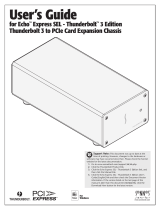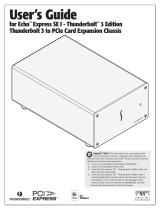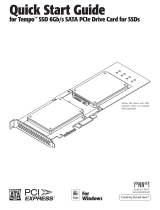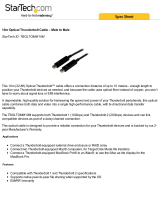Sonnet Echo Express SEL Thunderbolt 2 Edition User guide
- Category
- Network equipment chassis
- Type
- User guide
This manual is also suitable for

User’s Guide
for Echo
™
Express SEL
Thunderbolt
™
2
-to-PCIe Card Expansion Chassis
For
Windows


1 Introduction and System Requirements 1
2 Echo Express SEL Description 2
Echo Express SEL Exterior
Echo Express SEL Inner Assembly
Echo Express SEL Power Adapter
Thunderbolt Cable
Thunderbolt Connector Retainer Clip
3 PCIe Card Installation Steps 4
4 Verify Connections Using System Information 7
Verify the Echo Express SEL is Recognized
Verify the Installed Card is Recognized
5 Tips, General Information, and Known Issues 8
Tips, General Information
Known Issues
6 Specifications, Precautions, FCC Compliance, and Support Information 9
Specifications
Safety Precautions
FCC Compliance
Contacting Customer Service
Visit Our Website
Contents

This page left intentionally blank

1
Chapter 1 – Introduction and System Requirements
Introduction
Congratulations on your purchase! The Echo Express SEL is a
Thunderbolt 2 expansion system for PCIe cards. Through its
PCIe slot, you may connect a low-profile expansion card to your
iMac
®
, Mac
®
mini, Mac Pro
®
, MacBook Air
®
, or MacBook Pro
®
with Thunderbolt technology to expand its capabilities in ways
never before possible! With its Windows® support, the Echo
Express SEL offers you a handy way to connect an expansion
card to your desktop or laptop PC with Thunderbolt technology.
Mac Compatibility
• Mac computer with a Thunderbolt 2 or Thunderbolt port
• OS X
®
10.8.5 or later
Windows Compatibility
• Windows PC with a Thunderbolt 2 or Thunderbolt port*
• Windows 8, 7
System Requirements
While the Echo Express SEL chassis requires no drivers, the
expansion card you install does; Thunderbolt-compatible drivers
to enable it to work properly through the Thunderbolt interface
are required. More information on which cards are compatible
with Echo Express SEL is available at:
http://sonnettech.com/support/charts/thunderbolt/index.html
* To support more than two PCIe controllers, Windows requires a
Thunderbolt 2 interface in both the computer and the expansion
chassis. Note that some PCIe cards have a bridge to multiple
controllers, so it is possible for a single dual-controller PCIe card to
reach the limit if not connected via Thunderbolt 2. Not all Mac-
compatible PCIe cards are also compatible with Windows.

2
Echo Express SEL Exterior
1 – Power Indicator
This lights when the Echo Express SEL is powered, the
Thunderbolt cable between the chassis and your computer
is plugged in securely, and the computer powered on.
Note that if the Echo Express SEL is connected to another
Thunderbolt device instead of directly to the computer, any
other Thunderbolt device connected between the computer
and Echo chassis must also be powered on before the Echo
chassis’ power indicator will light up.
2 – 12V DC Socket
Connect the included DC power adapter between this socket
and the included power cord.
3 – Thunderbolt Ports
Connect the included Thunderbolt cable between either port
and your computer’s Thunderbolt port (or other Thunderbolt
device in the chain connected to the computer); the other may
be used to connect to another Thunderbolt device.
Chapter 2 – Echo Express SEL Description

3
Echo Express SEL Inner Assembly
1 – Thunderbolt Interface Card
This is installed into its own slot and
may not be moved to the PCIe slot.
2 – PCIe Slot
This is an x8 mechanical (x4 electrical)
PCIe 2.0 slot. It is also compatible with
PCIe 1.1 and 3.0 cards. Note that the
use of a low-profile bracket on the
card installed into the slot is required.
3 – Fan
The temperature-controlled fan
provides cooling for the installed
PCIe card and the chassis’ supporting
Thunderbolt circuitry. It operates at
a whisper when the card is running
cool, and speeds up when the
temperature rises. Do not block the
vent holes on the back of the chassis
to prevent overheating.
Echo Express SEL Power Adapter
1 – Power Adapter
Connect this to the Echo Express SEL
chassis’ power port. Note that the
power indicator on top lights when
the adapter is connected to AC power.
2 – Power Cord
Connect this between a power outlet
and the power adapter. Note that
the power cord included with your
product may appear different than
the one pictured here, depending on
where the product was purchased.
Thunderbolt Connector Retainer Clip
This secures a Thunderbolt connector
plugged into the Echo chassis’
Thunderbolt port to prevent accidental
cable disconnection. This clip is not
compatible with optical Thunderbolt
cables.
Thunderbolt Cable
Connect this cable between the
Echo chassis and your computer
(or other Thunderbolt
device in the chain
connected to the
computer).
Chapter 2 – Echo Express SEL Description

4
Chapter 3 – PCIe Card Installation Steps
Figure 1
1. Remove the Echo Express SEL chassis from its packaging, and then set it
upside-down on a soft, flat, level surface.
2. Remove and set aside the four screws securing the feet to the
bottom of the outer case (Figure 1). Set aside the screws
and feet.
3. Turn the Echo Express SEL chassis right-side-up
(Figure 2).
4. Place your hand on top of the outer
case. Remove the inner assembly
by gently grasping its faceplate by
the edges and pulling (Figure 3).
Set aside the outer case.
5. Remove and set aside the screw used to secure a PCIe card from the
Echo Express SEL chassis’ inner assembly (Figure 3).
Support Note: To avoid damaging components due
to static electricity discharge, wear an antistatic wrist
strap while working inside Echo Express SEL.
Figure 2
Figure 3
Inner
Assembly
Outer
Case

5
Chapter 3 – PCIe Card Installation Steps
6. Remove the PCIe card from its packaging, handling
the card by its edges and without touching any
components or gold connector pins.
7. If necessary, swap the card’s standard PCIe bracket with its included
low-profile bracket.
8. Holding the card with its bracket on the left
and the connector pins facing away from
you, line up its connector with the
slot, and then gently but firmly
insert the card straight into the slot;
do not rock the card or force the
card into the slot. If you
encounter excessive resistance,
check the card’s connector and the
slot for damage, and then try inserting
the card again (Figure 4).
9. Secure the card using the screw you removed previously;
do not overtighten the screw (Figure 4).
10. Place your hand on top of the outer case, and then gently push the
inner assembly back into the outer case (Figure 5).
11. Turn the Echo Express SEL chassis upside-down, and then secure the
outer case to the inner assembly by reattaching the four feet; do not
overtighten the screws (Figure 6).
WARNING: When handling computer products,
take care to prevent components from being
damaged by static electricity; avoid working in carpeted
areas. Handle expansion cards only by their edges and
avoid touching connector traces and component pins. Also,
avoid touching the Echo Express SEL chassis’ circuit boards
and any of its components.
Figure 4
Figure 6
Figure 5

6
Chapter 3 – PCIe Card Installation Steps
12. Turn the Echo Express SEL right-side-up.
13. Connect the included Thunderbolt cable between either Thunderbolt
port on the Echo chassis and a Thunderbolt port on your computer,
or other Thunderbolt device in the chain connected to the
computer (Figure 8). Secure the retainer clip to the chassis
if you attached it. If you are daisy chaining additional
Thunderbolt devices, connect another Thunderbolt cable
between the downstream device and the open
Thunderbolt port on the Echo chassis.
14. Connect the included power cord between a wall outlet
or power strip and the power adapter; verify the
connector is plugged in securely. Note that the power
adapter’s power indicator will light at this time.
15. Connect the power adapter cable to the Echo Express SEL’s 12V power
socket. Note that the power indicator on the Echo Express SEL chassis
will not light until the computer, and any other Thunderbolt device
connected between it and the Echo chassis, is powered on.
Support Note: Sonnet’s ThunderLok™ Thunderbolt connector
retainer clip secures the included Thunderbolt cable to the Echo
chassis to prevent accidental disconnects. Although it is compatible with
some other copper Thunderbolt cables like Apple’s, it is not compatible with
optical Thunderbolt cables.
To attach the clip to the cable, remove them from their packaging. Turn one
of the cable’s connectors so the Thunderbolt icon is facing down, and then
insert the connector into the connector clip as shown (Figure 7). Note that
the connector will pass all the way through the clip; when you connect the
cable to the chassis, the clip will secure the cable.
Support Note: To ensure the best performance possible when
connecting multiple Thunderbolt devices in a daisy chain, be sure to
connect 20Gbps Thunderbolt 2 devices such as this Echo chassis closest to
the computer, with 10Gbps Thunderbolt devices at the end.
Figure 7
Figure 8

7
Chapter 4 – Verify Connections Using System Information
Figure 9
Figure 10
A – Verify the Echo Express SEL is Recognized
1. With the Echo chassis powered and connected to the
computer, turn on the computer.
2. From the Apple menu, select About This Mac; the
System Information application will launch.
3. When the About This Mac window opens, click More
Info; a summary of specifications will appear.
4. Click System Report; a full report window will appear.
5. In the System Information window, click Thunderbolt
under the Hardware header in the left column
(Figure 9).
6. In the top right column under the Thunderbolt Device
Tree header, you will see the computer, followed
by Thunderbolt Bus, and then “Echo Express SEL”
(Figure 9).
B – Verify the Installed Card is Recognized
1. Click PCI Cards under the Hardware header in the left
column (Figure 10).
2. At the top of the right column, the installed card is
listed. By selecting the card, detailed information is
listed. You should see “Yes” next to Driver Installed and
Tunnel Compatible, otherwise the card or driver may
not be Thunderbolt-compatible (Figure 10).
Support Note: If you do not see “Echo Express SEL”
listed, disconnect and reconnect the Thunderbolt
cable between the computer and Echo Express SEL. Note
that it is not necessary to shut down the computer before
disconnecting and reconnecting the cable, so long as the
installed card is Thunderbolt-compatible.
Support Note: While the Echo Express SEL
expansion chassis requires no drivers, the installed card
requires Thunderbolt-compatible drivers to enable its use.

Chapter 5 – Tips, General Information, and Known Issues
KNOWN ISSUES
Not all PCIe Cards Will Perform at 100%
Thunderbolt 2’s PCIe bandwidth is limited to 20Gbps. While
most cards will operate at full performance, some may not due
to the fact they require more bandwidth than Thunderbolt 2 is
capable of supporting.
OS X Updates May Break Compatibility
Specific device drivers that work under one version of OS X
may not work under a later version. Before updating to the
latest OS, we recommend that you contact your PCIe card’s
manufacturer to verify that the existing drivers work. Note
that other software updates for the computer may also break
compatibility.
Some Devices’ Performance May be Affected by Where They
Are Connected in a Thunderbolt Chain
However small, Thunderbolt introduces latency to a device chain.
If you expand with additional Thunderbolt expansion chassis,
you may need to experiment with which cards work better in
chassis closer to or farther from the computer in the chain
Thunderbolt Support Under Windows is Incomplete
At the time of this writing, Intel and Microsoft have not settled
on a certification standard for Thunderbolt devices under
Windows. The main unresolved issues are how hot-plugging
support and Sleep mode support for Thunderbolt devices are
handled. Support for these features exists under OS X, but is still
in development under Windows. While Thunderbolt-compatible
cards will function in your Echo expansion chassis when
attached to your computer at boot, we cannot guarantee how the
Windows driver will respond to hot-plugging of the Thunderbolt
cable after boot or how it will operate when returning from sleep.
While we do expect these issues to be resolved in the future, at
the present they are not.
TIPS, GENERAL INFORMATION
Keeping the Card Cool
With its optimized airflow design and temperature-controlled
fan providing cooling at all times, Echo Express SEL provides
adequate cooling for the installed card. Do not operate the Echo
Express SEL with its cover off, and do not block any of the vents!
Otherwise, the installed card and Echo Express SEL’s components
may overheat.
Hot Plugging the Echo Express SEL – Mac Users
When a certified Thunderbolt-compatible card (used with
Thunderbolt-compatible drivers) is installed in the Echo Express
SEL, you may connect and disconnect the chassis while the
computer is on. Of course, if you have anything connected to
the card, such as storage devices, cameras, etc., follow proper
procedures for disconnecting those devices before unplugging the
Echo Express SEL chassis.
There’s No Need to Unplug the Power Adapter
Because Echo Express SEL automatically powers on and off with
the computer to which it’s connected, there’s no power switch,
nor is there any need to disconnect the power cable under
normal use.
Power Indicator Operation
Because the Echo Express SEL chassis automatically powers on
and off with the computer to which it’s connected, its power
indicator only lights when the computer is on, and turns off
when the computer is sleeping or powered off. Note that the
power adapter’s power indicator remains lit as long as it is
connected to a live power outlet.
Connecting Additional Thunderbolt Devices
You may connect up to six Thunderbolt devices total in a daisy
chain, including the Apple Thunderbolt Display.
Using Expansion Cards Without Drivers
Some Thunderbolt-compatible expansion cards, like Sonnet’s
Presto
™
Gigabit Pro PCIe and Sonnet’s Tempo
™
SATA Pro 6Gb
PCIe 2.0 eSATA card, use drivers built into the OS.
Some PCIe Cards May Not Fit in Echo Express SEL
Cards installed into Echo Express SEL must be no more than 6.6
inches (16.76 cm) long, and must have a low-profile PCIe card
bracket attached.
Replacing a Card After Initial Installation
Shut down the computer, and then disconnect the power adapter
and Thunderbolt cables from the Echo Express SEL before
disassembling the chassis and replacing the card.
PCIe CARDS ARE NOT HOT-PLUGGABLE!
Never install a PCIe card into Echo Express SEL while it is
connected to a computer or power outlet! If you do, you risk
injury, and damage to the card, chassis, and computer.
8

Chapter 6 – Specifications, Precautions, FCC Compliance, and Support Information
FCC Compliance
Echo Express SEL complies with Part 15 of the FCC Rules.
Operation is subject to the following two conditions: This device
may not cause harmful interference, AND this device must accept
any interference received, including interference that may cause
undesired operation.
Contacting Customer Service
The Sonnet Web site located at www.sonnettech.com has the
most current support information and technical updates. Before
you call Customer Service, please check our Web site for the latest
updates and online support files, and check this User’s Guide for
helpful information.
When you call Customer Service, have the following information
available so the customer service staff can better assist you:
• Product name
• Date and place of purchase
• Computer model
• PCIe card models
• Operating system version
• Software/firmware versions
USA Customers
If further assistance is needed, please contact Sonnet Customer
Service at:
Tel: 1-949-472-2772
(Monday–Friday, 7 a.m.–4 p.m. Pacific Time)
E-mail: support@sonnettech.com
For Customers Outside the USA
For support on this product, contact your reseller or local
distributor.
Visit Our Web Site
For the most current product information and online support
files, visit the Sonnet Web site at www.sonnettech.com/support/.
Register your product online at http://registration.sonnettech.com
to be informed of future upgrades and product releases.
Specifications
External Connectors • Two Thunderbolt
• Power
Expansion Slot x8 mechanical (x4 electrical) PCIe 2.0
PCIe Card Support Low-profile PCIe card
Compatible PCIe Cards See Sonnet Website:
(www.sonnettech.com)
Power Adapter Universal 80W, 100-240V AC,
50-60 Hz
PCIe Card Minimum
Guaranteed Power
25W
Operating
Temperatures
+32˚ F to +95˚ F
(0˚ C to +35˚ C)
Dimensions WxDxH 4 x 8.25 x 2.86 in.
(10.3 x 21 x 7.28 cm)
Weight 1.85 lbs.
(.84 kg)
RoHS Compliant Yes
Package Contents • Echo Express SEL chassis
• Power adapter
• Power cord
• Thunderbolt cable
• Thunderbolt connector retainer clip
• User’s guide
SAFETY PRECAUTIONS
Please read this section carefully before proceeding. These
precautions explain the correct and safe use of this device,
thereby helping to prevent injury to you or others, and also help
you to minimize the risk of damaging the device.
Warnings
Always follow the basic warnings listed here to avoid the risk of
serious injury or death from electrical shock, short-circuiting, fire,
and other hazards. These warnings include, but are not limited to:
• Do not attempt to modify the enclosure. If this device appears
to be malfunctioning, contact your reseller or local distributor
• Do not drop the chassis; dropping or mishandling the chassis
may result in a malfunction leaving the product inoperable
• Do not expose the device to rain, use it near water or containers
that contain liquids which might spill into any openings, or in
damp or wet conditions
• If unusual smells, sounds, or smoke come from the device, or if
liquids enter it, switch it off immediately and unplug it from the
electrical outlet
• Follow the instructions in this manual carefully; contact your
reseller or local distributor for additional advice not covered in
this User’s Guide
9

©2015 Sonnet Technologies, Inc. All rights reserved. Sonnet, the Sonnet logotype, Simply Fast, the Simply Fast logotype, Echo, Presto, and Tempo are trademarks of Sonnet Technologies, Inc.
iMac, Mac, the Mac logo, MacBook Air, MacBook Pro, Mac Pro, and OS X are trademarks of Apple Inc., registered in the United States and other countries. Thunderbolt 2 and the Thunderbolt
logo are trademarks of Intel Corporation in the U.S. and/or other countries. Other product names are trademarks of their respective owners. Product specifications subject to change without
notice. Printed in the USA. UG-ECHO-EXP-SEL-E-C-022515


-
 1
1
-
 2
2
-
 3
3
-
 4
4
-
 5
5
-
 6
6
-
 7
7
-
 8
8
-
 9
9
-
 10
10
-
 11
11
-
 12
12
-
 13
13
-
 14
14
-
 15
15
-
 16
16
Sonnet Echo Express SEL Thunderbolt 2 Edition User guide
- Category
- Network equipment chassis
- Type
- User guide
- This manual is also suitable for
Ask a question and I''ll find the answer in the document
Finding information in a document is now easier with AI
Related papers
-
Sonnet RackMac mini Quick start guide
-
Sonnet RackMac mini (2018) Quick start guide
-
Sonnet RackMac mini Quick start guide
-
Sonnet Echo Express SE I User guide
-
Sonnet Echo Express SEL User guide
-
Sonnet Echo Express SE I User guide
-
Sonnet Echo Express SE II User guide
-
Sonnet Echo Express III-D - Thunderbolt 3 Edition User guide
-
Sonnet Echo Express SE III/SE IIIe User guide
-
Sonnet Echo Express III-R - Thunderbolt 3 Edition User guide
Other documents
-
 Sonnet Technologies ECHO-EXP-SEL-T3 User guide
Sonnet Technologies ECHO-EXP-SEL-T3 User guide
-
 Sonnet Technologies ECHO-EXP-SE1-T3 User guide
Sonnet Technologies ECHO-EXP-SE1-T3 User guide
-
 Sonnet Technologies TSATA6-SSD-E2 User guide
Sonnet Technologies TSATA6-SSD-E2 User guide
-
 StarTech.com TBOLTOMM10M Datasheet
StarTech.com TBOLTOMM10M Datasheet
-
StarTech.com TBOLTMM2MW Datasheet
-
Blackmagic DaVinci Resolve 11 Configuration Guide
-
Blackmagic DaVinci Resolve 10 Specification
-
StarTech.com TBOLTMM1M Datasheet
-
 StarTech.com TBOLTMM2M Datasheet
StarTech.com TBOLTMM2M Datasheet
-
Blackmagic DaVinci Resolve 12 Configuration Guide




















